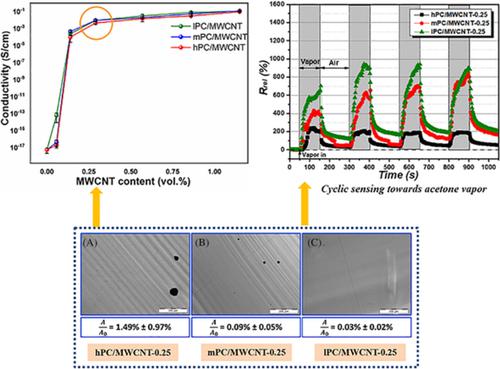当前位置:
X-MOL 学术
›
Polym. Compos.
›
论文详情
Our official English website, www.x-mol.net, welcomes your feedback! (Note: you will need to create a separate account there.)
The effect of polymer molecular weights on the electrical, rheological, and vapor sensing behavior of polycarbonate/multi-walled carbon nanotube nanocomposites
Polymer Composites ( IF 5.2 ) Pub Date : 2022-06-24 , DOI: 10.1002/pc.26799 Yilong Li 1 , Xuyuan Duan 1 , Cong Nie 1 , Yunchao Jia 1 , Hongjuan Zheng 1
Polymer Composites ( IF 5.2 ) Pub Date : 2022-06-24 , DOI: 10.1002/pc.26799 Yilong Li 1 , Xuyuan Duan 1 , Cong Nie 1 , Yunchao Jia 1 , Hongjuan Zheng 1
Affiliation

|
Conductive polymer composites (CPCs) based on polycarbonate/multi-walled carbon nanotubes (PC/MWCNT) were fabricated by melt mixing. By selecting the PCs with different molecular weights, three kinds of PC/MWCNT composites were obtained. The CPCs containing low viscous PC (lPC) had the lowest percolation threshold (0.06 vol%) as compared to those of medium viscous PC (mPC) (0.07 vol%) and high viscous PC (hPC) (0.13 vol%), which was attributed to the best MWCNT dispersion in matrix. Light microscopy images also demonstrated that lPC/MWCNT composite had the smallest undispersed filler agglomerates than the other two corresponding PC/MWCNT composites with the same filler loading (0.25 wt%). In terms of rheological measurements, rheological percolation occurred at a lower filler content for lPC/MWCNT than mPC/MWCNT and hPC/MWCNT composites. The chemo-resistive properties of composites towards organic vapors were investigated by measuring relative resistance change of CPCs upon vapor immersion-drying cycles. CPCs exhibited different sensing tendencies towards different organic vapors. lPC based CPCs exhibit higher relative resistance change as compared to mPC and hPC based CPCs because of their loosely overlapped conductive network, which are easily changed under polymer swelling. Besides, sample thickness is another factor that determined the vapor sensing performance of CPCs. Furthermore, relative resistance change of composites is found to be closely related with vapor concentration. This work presents a new thought in understanding filler dispersion in PC with different molecular weights, which has implication of turning conductive network structure and sensing performance of composites.
中文翻译:

聚合物分子量对聚碳酸酯/多壁碳纳米管纳米复合材料的电学、流变学和蒸汽传感行为的影响
基于聚碳酸酯/多壁碳纳米管 (PC/MWCNT) 的导电聚合物复合材料 (CPC) 通过熔融混合制造。通过选择不同分子量的PC,得到了三种PC/MWCNT复合材料。与中粘度 PC (mPC) (0.07 vol%) 和高粘度 PC (hPC) (0.13 vol%) 相比,含有低粘度 PC (lPC) 的 CPC 的渗透阈值最低 (0.06 vol%),分别为归因于基质中最好的MWCNT分散。光学显微镜图像还表明,与其他两种相应的具有相同填料含量(0.25 wt%)的 PC/MWCNT 复合材料相比,lPC/MWCNT 复合材料具有最小的未分散填料团聚体。在流变测量方面,与 mPC/MWCNT 和 hPC/MWCNT 复合材料相比,lPC/MWCNT 的流变渗透发生在较低的填料含量下。通过测量 CPC 在蒸汽浸渍干燥循环中的相对电阻变化,研究了复合材料对有机蒸汽的耐化学腐蚀性能。CPCs 对不同的有机蒸气表现出不同的传感倾向。与基于 mPC 和 hPC 的 CPC 相比,基于 lPC 的 CPC 表现出更高的相对电阻变化,因为它们的导电网络松散重叠,在聚合物溶胀下很容易改变。此外,样品厚度是决定 CPC 蒸汽传感性能的另一个因素。此外,发现复合材料的相对电阻变化与蒸气浓度密切相关。这项工作为理解不同分子量的 PC 中的填料分散提供了一种新思路,
更新日期:2022-06-24
中文翻译:

聚合物分子量对聚碳酸酯/多壁碳纳米管纳米复合材料的电学、流变学和蒸汽传感行为的影响
基于聚碳酸酯/多壁碳纳米管 (PC/MWCNT) 的导电聚合物复合材料 (CPC) 通过熔融混合制造。通过选择不同分子量的PC,得到了三种PC/MWCNT复合材料。与中粘度 PC (mPC) (0.07 vol%) 和高粘度 PC (hPC) (0.13 vol%) 相比,含有低粘度 PC (lPC) 的 CPC 的渗透阈值最低 (0.06 vol%),分别为归因于基质中最好的MWCNT分散。光学显微镜图像还表明,与其他两种相应的具有相同填料含量(0.25 wt%)的 PC/MWCNT 复合材料相比,lPC/MWCNT 复合材料具有最小的未分散填料团聚体。在流变测量方面,与 mPC/MWCNT 和 hPC/MWCNT 复合材料相比,lPC/MWCNT 的流变渗透发生在较低的填料含量下。通过测量 CPC 在蒸汽浸渍干燥循环中的相对电阻变化,研究了复合材料对有机蒸汽的耐化学腐蚀性能。CPCs 对不同的有机蒸气表现出不同的传感倾向。与基于 mPC 和 hPC 的 CPC 相比,基于 lPC 的 CPC 表现出更高的相对电阻变化,因为它们的导电网络松散重叠,在聚合物溶胀下很容易改变。此外,样品厚度是决定 CPC 蒸汽传感性能的另一个因素。此外,发现复合材料的相对电阻变化与蒸气浓度密切相关。这项工作为理解不同分子量的 PC 中的填料分散提供了一种新思路,


























 京公网安备 11010802027423号
京公网安备 11010802027423号